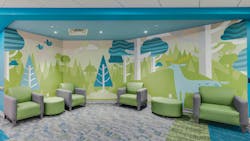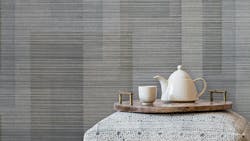Creating Healthy Spaces with Wallcoverings in Healthcare
When people go to healthcare facilities to visit a loved one, get a checkup, or have a procedure done, the last thing on their minds is what’s on the walls they’re looking at. It’s usually a mild aesthetic designed to fade into the background.
But design professionals can’t stop thinking about all the details of a space. They know that the surroundings impact how the occupants think, feel, and even heal, so every detail is being carefully considered.
After the color and design needs are met, specifiers must also take into consideration durability, cleanability, disinfectability (can we just decide that’s a word?), and indoor air quality (IAQ). Facilities can’t have walls that hold onto stains or worse, bacteria or viruses. Choosing finishes that meet the aesthetic needs of a space combined with inherent cleanability makes vinyl wallcovering an easy choice for today’s high-demand spaces.
Vinyl wallcoverings fit the bill. They’re naturally PFAS-free, extremely durable, up to any task, and use non-toxic adhesives during installation.
With the latest innovation of digital wallcoverings, we’re able to take it up another level by creating less waste with custom-designed and measured wallcoverings, incorporating the healing elements of biophilia, art, and visual psychology into the spaces that need calming — healthcare facilities.
Understanding PVC and PFAS
At a certain point the acronyms all start to blend together until you don’t know what’s good, what’s bad, and what you need to pay attention to. So let’s conduct a quick chemistry lesson!
- PVC or polyvinyl chloride. PVC is the acronym for polyvinyl chloride. This is literally the chemical name for vinyl (PVC=Vinyl). For decades it has been a reliably durable performer with relatively high fire resistance and at an unbeatable price. Vinyl, when specified, will do the job it was installed to do for longer than the needs of most spaces. Dollar for dollar, it is the longest lasting finish on most projects. We like to say that, “Vinyl goes ugly before it wears out.”
- PFAS or per- and polyfluoroalkyl substances. PFAS are a collection of chemicals added to products to resist water, oil, and grease giving the surface improved stain resistance. These are often called ‘Forever Chemicals’ due to their resistance towards breaking down in the environment or the body and the reason they’ve become so (un)popular. Many sustainably built buildings already avoid these chemicals.
Vinyl Wallcovering Is a Healthcare Rockstar
Checking into a mid-range hotel in many parts of the country, you’ll find vinyl in every corridor and in most guest rooms and baths, too. It is selected for the upscale feeling it provides with unbeatable durability.
The same case can be made for vinyl in healthcare institutions as well. During the recent COVID upheaval, we saw countless products made of vinyl alternates fail. They simply weren’t up to the task of enhanced COVID cleaning protocols including increased cleaning schedules with harsher chemicals.
Vinyl wallcoverings and flooring and furniture, on the other hand, were able to handle the added cleaning without needing to be replaced.
Vinyl Is Durable and Regularly Improved for Sustainability
At every turn, manufacturers have improved formulas, replaced chemicals, and cleaned up manufacturing methods. Today, nearly all wallcoverings made in the USA are low-VOC, have switched to non-phthalate plasticizers, and eliminated harmful additives.
To support these initiatives, the Wallcoverings Association has developed a multi-attribute standard that helps to verify the claims of manufacturers and to provide a road map for them to constantly improve the supply chain, labor practices, and materials to ensure they are working to benefit workers, users, and the planet alike.
The standard, called ANSI/NSF 342, evaluates the full life cycle of a product and can act as a cheat code to ensure everyone is playing by the rules. It’s a robust standard that:
- Asks manufacturers to identify the source of all the raw materials
- Rewards products that use safer chemicals
- Measures the waste generated during manufacturing
- And more
PFAS-free and Fabulous
While most people familiar with the subject will de-select PFAS chemicals, it can be tricky to know what to choose and what to avoid. The properties that people sought when selecting products treated with those chemicals are, for the most part, absent from standard PVC formulation. It’s always safest to check, but if a wallcovering is made in the U.S., chances are it is PFAS-free.
Wallcovering Goes Digital
Imagine: instead of sitting in a waiting room staring at boring, beige paint that’s getting uglier by the second, you’re facing a work of art. Instead of counting cracks, you’re immersed in a forest or a room full of fluffy kittens.
Behold: digital wallcoverings! These projects can be easily adapted with no size constraint and customized to the specific needs of a healthcare facility.
- Want to display a mural designed and created by a local artist? Done!
- Want a design to calm worried and anxious families in a waiting room? Done!
- Want a custom design no other facility has that meets a hyper specific need? Done!
Murals are custom-designed for your project with no size constraints. They can even maximize the benefits of biophilia making the space feel less institutional and more calming.
They come in a variety of substrates such as durable vinyl, rigid panels, acoustical panels, lightweight breathable films, shiny mylar, and more. The minimums to produce are low and the bang for your buck is high.
Blending the artistry and durability into a common area can help projects meet the brand requirements and support healing.
And really, what more can we really ask of a wallcovering?
About the Author
Giselle Walsh
After a career of over 20 years of industry experience, Giselle Walsh founded Juno Solutions Group in 2016 to assist organizations to expand their reach into the architecture and design markets to achieve greater market success. Juno Solutions Group’s passionate team of professionals is committed to marketing, sustainability, and employee training needs. In 2015 The Wallcoverings Association awarded Giselle with the President’s Award for her efforts to create the NSF 342 online CEU training module, conduct training sessions at TecTrac, the wallcovering industry’s premier training program, and presenting the CEU at NeoCon. Giselle also worked with The Wallcoverings Association on the technical committee from 2008 to 2016 on such projects as the development and ongoing modification of the NSF 342 standard.



